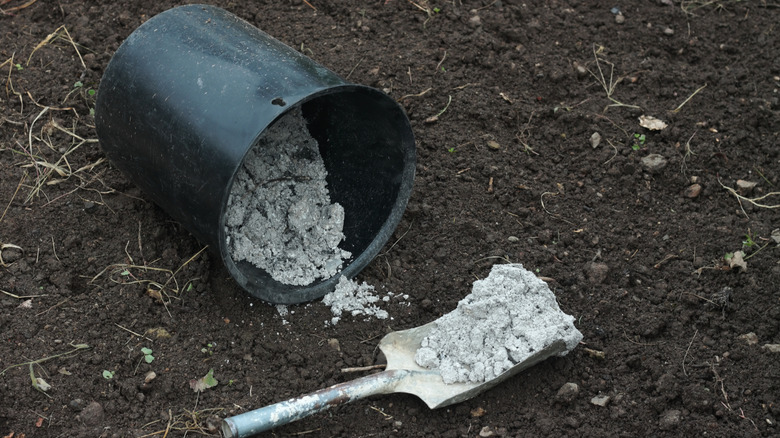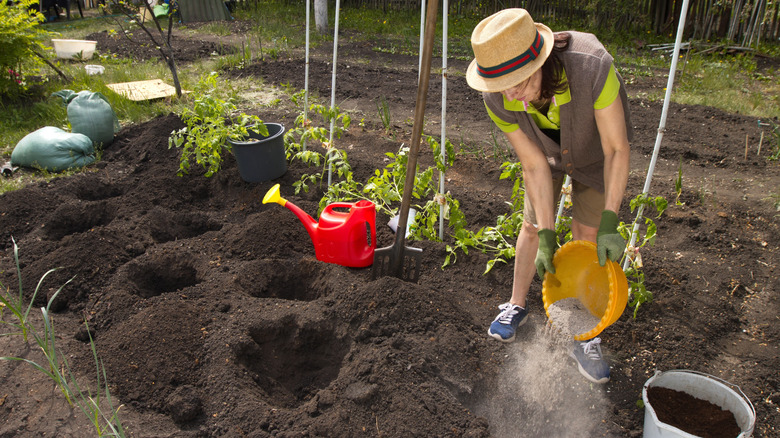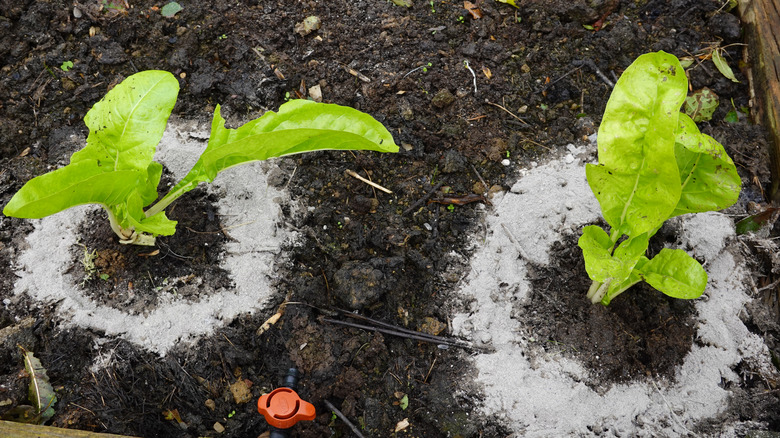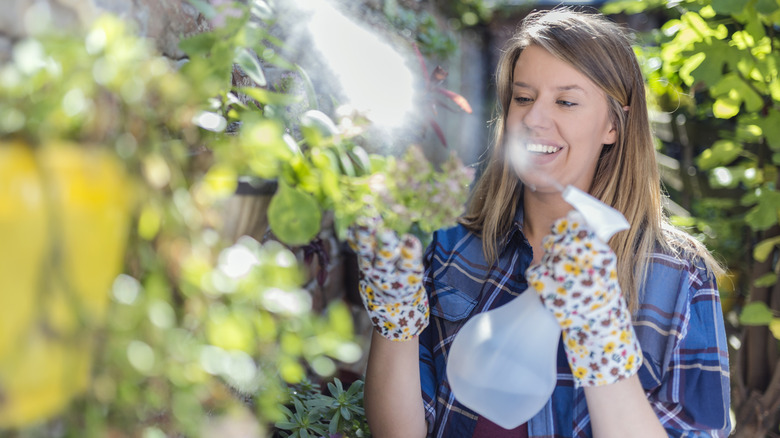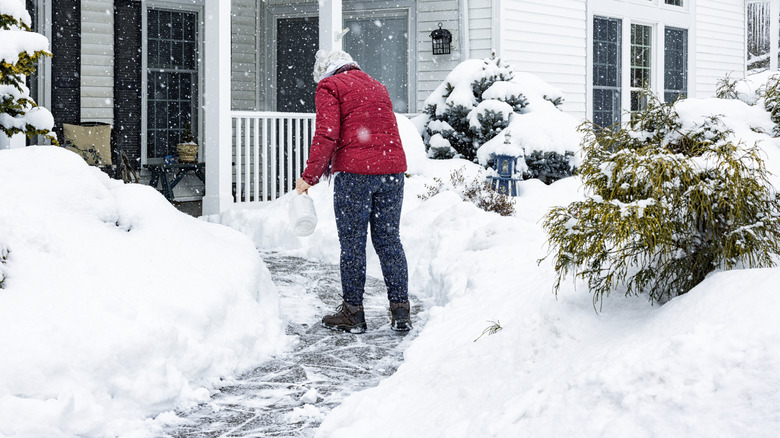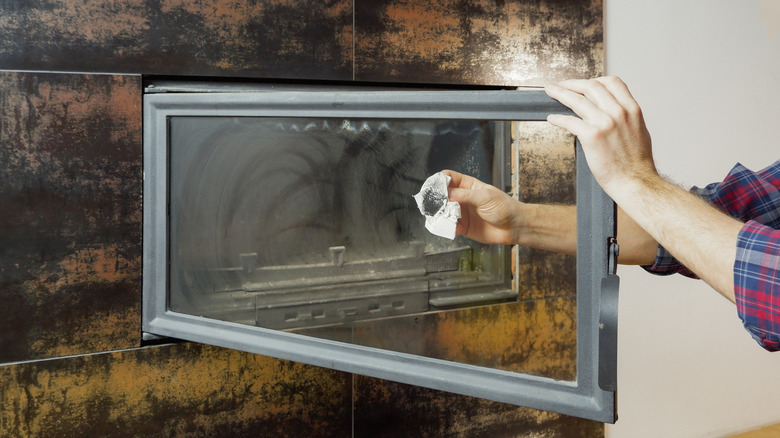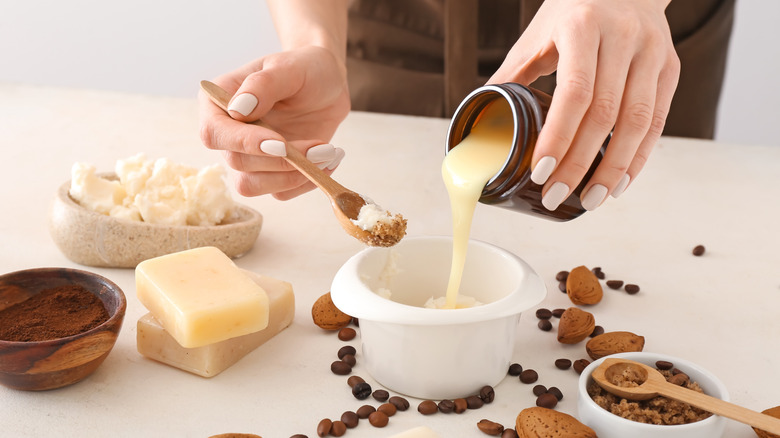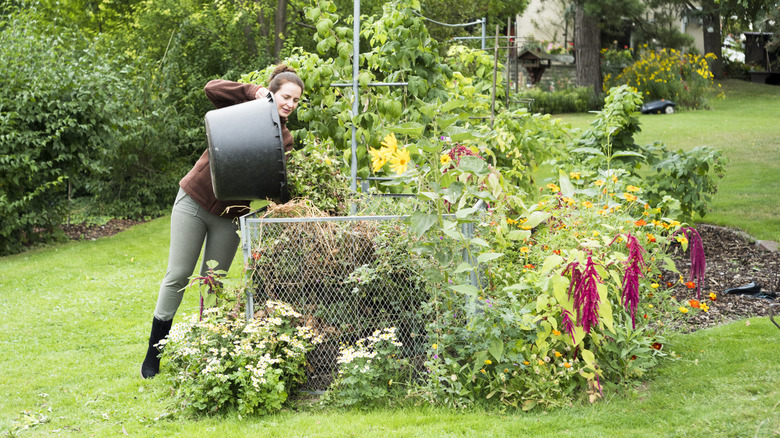11 Ways To Repurpose Fireplace Ash Around Your Home And Garden (& 1 To Skip)
If you regularly burn wood in your fireplace or woodstove, you're familiar with how much ash gets left behind. Too often, the backbreaking work of constantly sweeping the grates feels like a thankless task. Fortunately, all those buckets of ash can actually become "sooty gold" for your home and garden.
Not surprisingly, over millennia, dozens of uses for fireplace ash have been explored. Some have been discarded along the way, but many of these time-tested methods for using the wood ash from your fireplace are still viable. Wood ash, especially from hardwood, is full of nutrients like calcium and potassium that your garden craves. It's also a traditional method for "sweetening" (de-acidifying) the soil and chasing off insects and plant diseases. And in the home, wood ash makes a useful cleaning and dehumidifying agent.
Because wood ash is drying and alkaline, it's important to use caution when working with it. Wear long sleeves and long pants, gloves, a face mask, and protective eye wear when undertaking chores like sprinkling ash over the soil. And, of course, let recently-produced ash cool for several days before handling or applying it.
Ash is a great source of nutrients like calcium and potassium for your soil
Wood ash contributes valuable nutrients to garden and lawn soil. On average, wood ash is composed of about 20% calcium and 5% potassium. It also contains sulfur, phosphorus, and magnesium at rates of about 2%, and trace amounts of additional minerals, such as iron and zinc. That's why many gardeners work wood ash into their soil in late fall or early spring, before planting gardens or establishing lawns.
As with any garden amendment, it's important to know what your soil actually needs before working in any additions. Take a soil test of the areas you plan to enrich. These kits are readily available at your local university extension service. With these test results in hand, you'll know the current levels of key soil nutrients, as well as soil pH. The tests additionally recommend the amounts of various amendments that should be used for your particular plots of land. If your soil is low in calcium, potassium, or other key nutrients, wood ash may be the perfect solution. In general, don't exceed 20 pounds of ash per 1,000 square feet. That works out to about a 5-gallon bucket filled with ash. Start by sifting cold ashes into the bucket to remove larger chunks. On a non-windy day, sprinkle the ash over damp soil. Work the ash into the soil with a rake or spade, and be sure to wear gloves, protective clothing, and eye protection to avoid irritation.
Give potassium-loving plants a boost with ash
Even when soil tests reveal that your garden has adequate potassium, consider adding smaller amounts of the nutrient to the plants that crave it. Wood ash is rich in potassium. Along with nitrogen and phosphorus, potassium is one of the "big three" in fertilizer needs for edible and ornamental plants. Plants such as tomatoes, watermelons, and strawberries rely on the nutrient potassium for optimum growth. Because wood ash is high in it, adding even a small amount of potassium can boost growth and overall health. Other plants which appreciate the potassium that fireplace ash provides include cantaloupes, peaches and grapes.
Use about 1 to 1 1/2 pounds of wood ash per 100 square feet of garden bed. That works out to about 3 or 4 cups of wood ash. Don't just dust the surface of the soil with the ash, because it can blow away quickly, or leech salts downward if it just sits on the soil's surface. Instead, gently work the ash into the soil between plants with a trowel or garden fork. Be careful not to get the ashes too close to plant roots.
Bear in mind that even though potassium is a key nutrient for potato plant health, fireplace ash should not be used in the potato bed. In fact, wood ash has been associated with potato scab. That's because being grown at a higher pH level encourages the disease, and fireplace ash makes soil more alkaline.
Sweeten your acidic garden soil with pH-raising fireplace ash
If you've heard old-timers talk about the need to "sweeten" their farm or garden soils, it has to do with the need to correct overly-acidic soils. Acidic soils have a pH lower than the neutral score of between 6.0 and 7.5, which most (but not all) plants prefer. Wood ash increases soil pH for acidic soils, making it more useful for lawns, as well as flower and vegetable beds. Again, a soil test is useful before you apply fireplace ash or any other "liming" ingredients to acidic soils.
The results from your local extension service will tell you the current pH levels of various areas of your property. Just as importantly, you'll also get suggested application quantities for your chosen amendment. Often, a 5-gallon bucket is about right to correct pH for a 1,000 square foot area. Lightly scatter the ash over dampened soil, then work it in. This is best done in the fall or in early spring. Although the majority of plants prefer to grow in the neutral range, some prefer acidic soils. Don't add wood ash to areas in which you plan to establish blueberries, potatoes, azaleas, or rhododendrons. On the other hand, you might want to increase your fireplace ash application somewhat for landscape shrubs and trees that prefer alkaline soil, including certain maples and oaks, hydrangeas, and lantana.
Use ash to protect your plants from damaging garden pests
Gardens are under a continual barrage of flying and crawling pests. These insects leave unsightly holes in leaves, potentially weakening or killing the entire plant. Yet, many home gardeners are reluctant to use chemical deterrents, particularly on edible plants. Fortunately, the natural desiccant properties of alkaline wood ash help literally dry up insect pests like flea beetles when sprinkled on plants. Additionally, a barrier of fireplace ash can also repel garden pests, such as slugs and snails, along with larvae. The pests dislike crossing the barrier because of the drying, irritating quality of the ash.
If you notice small, round holes in your leafy greens or tomato and pepper foliage, flea beetles are likely the culprits. To deter them, sprinkle wood ash directly on the leaves. Keep the layer light, and reapply after rain. The gritty, alkali nature of the ash makes the leaves distasteful to the flea beetles. Crawling garden pests can be foiled by setting a circle of ash around individual plants, or a line of ash between rows. Again, keep the layer light to avoid salt content leeching into the soil. Reapply the ash barriers after rainfall.
Ash can naturally fight fungus and bacteria on plants
Along with garden pests, plant diseases are the bane of home gardeners everywhere, but many of the products targeted for fungal and bacterial infections are too full of chemicals or too expensive — or both. Yet, fireplace ash, either on its own or combined with other natural ingredients, may be the key to fighting some of the diseases. The natural ingredient helps eradicate the diseases by raising the soil pH and creating an inhospitable alkaline environment for bacteria and fungi.
Many organic methods involving fighting plant disease with wood ash involve using a spraying method. Start by sieving the fireplace ashes so that only a fine powder remains. To fight fungal infections such as clubroot and mildew, for example, add about 1 tablespoon of sieved wood ash to every 1 liter of water. After this mixture soaks overnight, strain it and add about 1 cup of sour milk and another 3 liters of water. To extend the range of insect and disease pests which this mixture targets, consider adding chopped Mexican marigold (Tagetes minuta), French marigold (Tagetes patula), or African marigolds (Tagetes erecta) to the initial soaking mixture before straining it.
Keep your tomatoes fresher for longer periods by storing them in ash
Got a bumper crop of tomatoes, but no time to can or freeze them? Wood ash may be a useful way to keep tomatoes fresh a few weeks longer, until you can get to longer-term storage. It's an unconventional approach, but new studies suggest that storing harvested tomatoes in fireplace ash extends their "shelf life." For home use, that means that embedding ripe tomatoes in cardboard boxes of cold fireplace ash can keep them at their ripened state longer, without spoiling.
Put enough cold wood ash into a small cardboard box until it is roughly the height of your tomatoes. Embed about four ripe, unblemished tomatoes in each ash-filled box. Sprinkle more ash on top if necessary. This method potentially keeps tomatoes fresh for about a month, as opposed to a few days without special storage. One important note? Studies on this method are still relatively new, and have been conducted in the southern hemisphere, using wood ash native to the area. While the experiment can be useful, especially for self-sufficient homesteaders, don't count on it for your full harvest — at least until you've seen the results for yourself.
De-slippify your icy walkways and parking areas with ash
Out of commercial ice melt? Or maybe you're concerned about the corrosive effects rock salt can have on plants? When your entrance steps, walkways, and parking areas are coated in ice or slippery snow, the solution may be hiding right under your fireplace grate! Wood ash provides traction and melting action on ice and snow. The reason it's effective is that the grittiness of wood ash provides traction to prevent shoes and tires from slipping. In addition, the potassium salts in fireplace ash results in melting, while the dark color of the ash helps retain the heat of the sun.
Sprinkle a thin layer of fireplace ash on paths, steps, and parking areas. If you don't find the thin layer effective, you can always go back and add additional ash. Needless to say, use ash that's been cold for several days. Keep covered buckets of fireplace ash on hand near your front door and garage. Add new ash after more snow or icy rain. Keep in mind that while using fireplace ash in place of rock salt or chemicals is kinder to the environment and sensitive pet paws, it can leave a mess on your kitchen floors and car interior! Be sure to have rugs to wipe shoes in both your home's entrance and inside your car.
Add fireplace ash to your organic housecleaning arsenal
We're all looking for ways to use more natural products in our housecleaning routines. If that organic material is free and already in your home, all the better! Fireplace ash has just the right amount of abrasion to be a useful cleaning agent, especially on glass and silver pieces. Use it on glass surfaces such as car headlights, wood stove windows, and glass fireplace inserts. It also works on pots and pans, along with silver and pewter. The key is to use ashes that are completely cooled, and which have been sifted in order to remove the chunkier, scratchier bits.
To clean smaller silver objects like jewelry, dab a clean, damp cloth into a small amount of fireplace ash. Rub the cloth into the surface of the silver, then rinse and dry the object. For larger pieces like serving trays, use a 1:1 mixture of ash and water. Spread it over the object, let it sit for a few minutes, then rinse and dry. The process is similar for wood stove and fireplace glass, as well as headlights. Make a paste of equal amounts of ash and water, gently rub the paste over the glass, then rinse and dry the surface. And, while the process of sifting and mixing the ash might be a bit tedious for scouring your pots and pans on a daily basis, it is an option when you're camping, or if you've run out of your regular dish washing products!
Use ash to produce lye for homemade soap making
Wood ash can be used to create your own lye, which is a primary ingredient in from-scratch soap. Of course, you can buy this caustic ingredient as a commercial product, known as sodium hydroxide crystals. But for a truly sustainable experience in creating both a practical and artisanal home good, consider making soap with lye produced from your own wood ashes. The only other primary ingredients needed are water and fat. Use distilled water or rainwater, and either animal tallow or vegetable oil. The fun part is choosing your optional additions, like essential oils, dried herbs, and healing products like oatmeal and honey.
Soap making can be done at home with minimal equipment, although safety when working with your ash-made lye is critical. People who plan on making a larger amount of soap, perhaps as a side business, set up an elevated barrel in their backyard to process lye from a larger quantity of wood ash and rainwater. To get started with home-produced lye, however, all you need is a non-aluminum pan and some ashes created from hardwoods. Boil in a small amount of water (distilled or rainwater is best). Once the ashes are settled in the bottom of the pan, carefully drain off the liquid lye. You may need to do this several times to have enough lye for your particular soap recipe. If the liquid lye can float an egg or potato in it, it's ready for soap making.
Harness ash's natural drying powers to solve a variety of household problems
The drying power of wood ash makes them useful for solving a variety of household headaches, without the extra cost or chemical fumes. Use your extra ash to treat a myriad of home issues, from moldy, damp basements to oil spills on the driveway and even pests. For damp areas, there's no need to sift through the ashes before using them as a dehumidifier and "must buster." Much as some owners put down charcoal briquettes in the basement to absorb moisture and musty odors, as well as to fight mold, chunky fireplace ash works in a similar way. Set several shallow bowls filled with about 1 cup of the ashes around these damp areas. And while you're down there, consider sprinkling lines of wood ash around the interior perimeter. Pests, such as ants and roaches, may be discouraged from crossing those lines, because of the drying effect on their exoskeletons.
Oil spills in garages, driveways, and basements are another common problem in search of a "dry out." Sprinkle wood ash over the surface of the spill. Let the treated spill sit for several hours before sweeping away the ashes. Much of the stain will be sucked up by the wood ash, while the remainder can ideally be scrubbed away.
Help shield your animals (and your family) from ticks and fleas using ash
Although it shouldn't necessarily be your first line of defense in controlling the tick and flea population in your yard and home, fireplace ashes might be helpful as part of your organic pest management system. Setting fireplace ash in strategic outdoor places is a method used by farmers to control tick populations in the coop. Even if you don't have your own backyard flock, sprinkling ash in out-of-the-way places in your backyard may be a useful method for your other pest control measures. That's because the dehydrating effect can kill pests in contact, and also discourage them from crossing barriers of it. It can also help discourage lice and fleas in your pet areas and on the pets themselves.
If you do have a flock, sprinkle fireplace ash into the areas in which they like to dust bathe. This can help control the tick population in the coop, particularly when it comes to soft ticks. Additionally, some pet owners lightly rub wood ash into their animals' fur in order to discourage fleas. You might also try sprinkling it under their dog or cat beds. If you do try any of these natural remedies with your own menagerie, ask your vet about it beforehand. Again, wood ash probably should not be your primary defense against tick invasions or flea infestations, but you may find it worth experimenting with as a useful backup.
Think twice about adding ash to the compost pile
While some experts suggest that small amounts of wood ash can be used to feed and deodorize backyard compost, others advise against it. One potential drawback ? Wood ash can sometimes "weigh down" the other materials you're using in your own DIY compost pile. That's because, unlike compost materials like leaves, grass, and banana peels, wood ash doesn't decompose. That inertia adds to the inability of the rest of the pile to draw in oxygen and heat up in order to decompose further. The University of Connecticut, for example, puts wood ash on its "harmful to pile" list of compost recommendations.
If you do decide to add wood ash to your outdoor compost pile, use scant amounts. Given the ability of compost to dramatically alter soil pH when used in high concentrations, it shouldn't make up more than 5% of your overall pile. That ratio can be hard to calculate when you're building the compost in stages, but if you add a light dusting every few layers of composted material, you're unlikely to exceed that amount.

